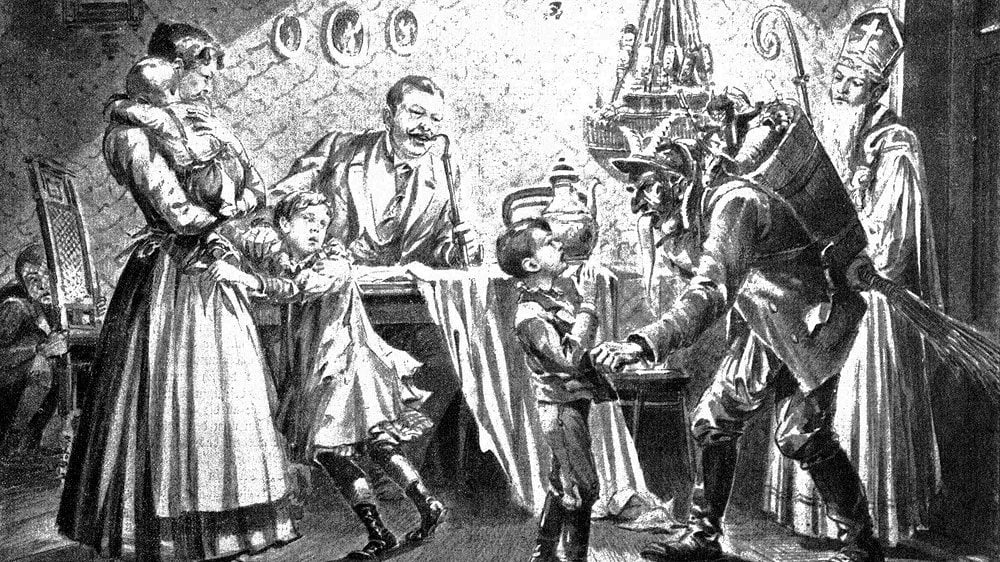The excitement is palpable in the video above as children await the arrival of visitors in Dienten am Hochkönig, a little mountain village in Austria.
Many Americans probably recognize St. Nicholas, whose feast day is December 6. A legendary bringer of gifts on the eve of his feast, St. Nicholas is the figure from whom the Dutch Sinterklaas and American Santa Claus derive, as well as the British Father Christmas.
But who are the hairy beasts accompanying Nikolaus as he makes his nighttime rounds on December 5, the eve of his feast?
Last year, the Austrian Times offered this explanation:
Krampus is a mythical devil who accompanies Saint Nicholas in various regions of the world during the Christmas season. He is often portrayed as a terrifying devil carrying a huge stick or a whip with which to beat bad children.
In Alpine regions, Krampus is represented by a demon-like creature accompanying Saint Nicholas. He gives gifts to good children, while Krampus gives warnings and punishments to bad children.
As the article goes on to explain, young men traditionally dress up as Krampus (plural: Krampusse) during the first two weeks of December — especially on December 5th — to roam the streets frightening children and women with rusty chains and bells. There’s also a beloved custom of beating women and children with sticks.
Here’s a music video by a wacky Eurorock throwback band out of California called Hard Place celebrating Krampus-time:
As is referenced in the song, Krampus is said to have a sack or a basket on his back which he uses to carry away bad children and dump them into the pits of Hell — so I suggested the Krampus tradition yesterday to my hair stylist, who is looking to steer her kids away from all the Santa ballyhoo. It certainly adds some gravity to the consequences of naughtiness.
Last year on The Colbert Report, host Stephen Colbert recommended adopting Krampus traditions in America as a part of the “Blitzkrieg on Grinchitude,” his counterstrike against the perceived “war on Christmas”:
According to Wikipedia, in the aftermath of the Austrian Civil War, the Krampus tradition was itself a target of Austrian Fascists allied with Nazi Germany.
Perchten, La Befana
Studying the history of Christmas reveals that a dark and menacing aspect of the season has been a part of the annual celebration since antiquity. There’s the olde British custom of a Lord of Misrule and the aggressive, trick-or-treat style demands associated with early wassailing — and, in addition to Krampus, there are the figures of Perchta (plural: Perchten) in the Alpine regions, and La Befana in Italy.
Perchta (or Berchta) and La Befana are both females, and both are associated with January 6 (or its eve on January 5). Back in medieval times, this “Twelfth Night” holiday marked the end of a winter festival which began way back on Halloween. In Christianity, January 6 is celebrated as the feast of the Epiphany.
As with Krampus, the Perchten serve as an entourage in parades and festivals. Some of them (the Schiachperchten or “ugly Perchten”) are played by men wearing animal masks with fangs and tusks. They drive out bad spirits. But there are also Schönperchten (“beautiful Perchten”) who bring luck and prosperity.
La Befana is an old witch woman who, in the manner of Saint Nicholas, brings gifts to children. She fills their socks with candy or presents if they are good, but delivers a lump of coal or dark candy if they are bad. Like a witch, she rides a broomstick through the air, and like Santa, she sometimes enters a house through the chimney. Families leave her a small glass of wine and a little food, and in return she sweeps the floor.
Unlike Krampus, La Befana is not especially scary — despite the organ music in the highlight reel above.









0 Comments